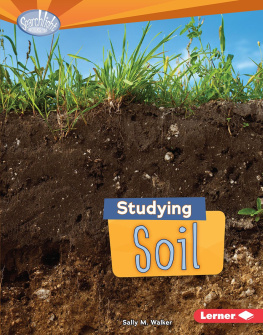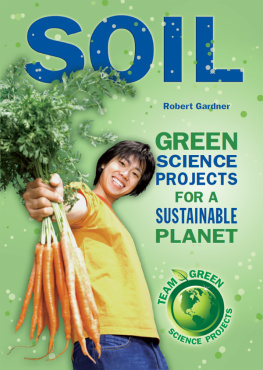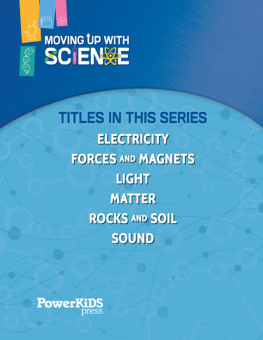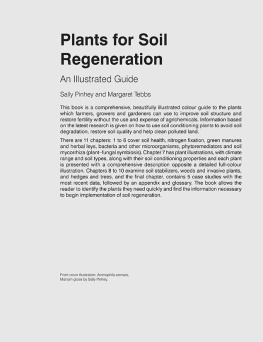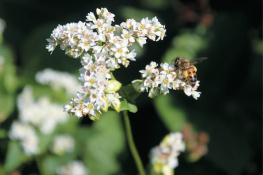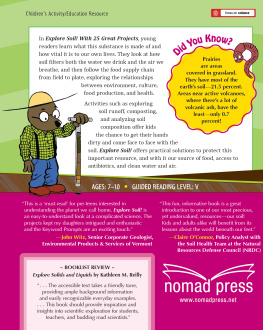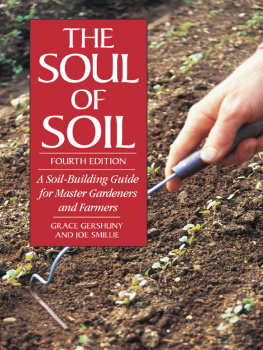Studying Soil Sally M. Walker
Copyright 2013 by Sally M. Walker
All rights reserved. International copyright secured. No part of this book may be
reproduced, stored in a retrieval system, or transmitted in any form or by any means
electronic, mechanical, photocopying, recording, or otherwisewithout the prior written
permission of Lerner Publishing Group, Inc., except for the inclusion of brief quotations in
an acknowledged review.
Lerner Publications Company
A division of Lerner Publishing Group, Inc.
241 First Avenue North
Minneapolis, MN 55401 U.S.A.
Website address: www.lernerbooks.com
Library of Congress Cataloging-in-Publication Data
Walker, Sally M.
Studying soil / by Sally M. Walker
p. cm. (Searchlight booksDo you dig earth science?)
Includes index.
ISBN 9781467700238 (lib. bdg. : alk. paper)
1. SoilsJuvenile literature. I. Title.
S591.3.W353 2013
577.57dc23 2012022475
Manufactured in the United States of America
1 PC 12/31/12
Contents
WHAT IS
SOIL? ... page
Chapter
WHAT IS
SOIL?
Did you ever
make mud pies
when you were
little? If you did,
soil was one of the
ingredients you used.
You may have called
it dirt instead of soil.
This field has good soil. A
farmer will grow plants in the
soil. What are some other
places where soil can be found?
Where Is Soil?
Soil is in lots of
places. You can
find soil under
the grass. It
surrounds tree
and flower roots.
It lies beneath
sidewalks and
streets. If you
could lift your
home, you would
probably find soil
under it too!
Tree roots
grow deep
into the soil.
Whats in Soil?
A scoop of soil contains many things. Soil has rocks in it.
Plants and bits of leaves are in soil. Many creatures live
in soil too.
You can be a soil detective. See what you can find
in the soil near your home. You will need a shovel. Ask
an adult where you may dig. Use your shovel to dig out
several handfuls of soil. Look closely at your soil. What
can you find in it?
IF YOU LOOK CLOSELY
AT SOIL, YOU MAY
FIND WORMS, INSECTS,
OR OTHER ANIMALS
LIVING IN IT.
Soil is a natural
resource. Natural
resources are
materials found
on Earth that
help living things.
They are made by
nature, not people.
Soil helps plants
and animals grow.
They cannot live
without it. But
where does soil
come from?
These plants
need soil to grow.
Chapter
HOW SOIL
FORMS
Soil is made up of different
kinds of materials. One of these
materials is bits of rock. Rocks are
broken pieces of bedrock. Bedrock
is the layer of solid rock that covers the
outside of Earth.
Hard rocks can break
into small pieces. How
can water break rocks?
Wind, Water, and Ice
Rocks are hard. But
they can be broken
into tiny bits. Tiny
bits are called
particles. Wind,
water, and ice are
strong enough to
break rocks.
Wind blows sand
grains against big
rocks. The sand
grains scrub off
particles of rock.
Rushing water in
rivers makes rocks
roll and tumble. The
rocks break into
smaller pieces. Tiny
particles of rock
break loose.
As water rushes down
this hill, it breaks off
bits of rock.
Rainwater seeps into cracks in rocks. If it gets cold
enough, the water freezes. It becomes ice. Ice takes up
more space than water. So the ice pushes against the
rock. It makes
the cracks
bigger. Pieces
of rock break
off.
Glaciers are
giant, moving
slabs of ice.
Glaciers are
very heavy.
Their weight
slowly grinds
big rocks into
small pieces.
Ice split this huge
rock in half.
Minerals
Rocks are made of minerals. A mineral is a hard
substance made in nature. Minerals are not alive, like
plants or animals. The minerals in a rock become part of
the soil when the rock breaks apart.
Minerals add nutrients to soil. Nutrients are
substances that help living things grow. Soil contains
nutrients that plants and animals need to stay healthy.
This glacier
carries rocks with
it as it flows.
Humus and Bacteria
Humus is the second material that is in soil. Humus is
dark brown or black. It is made of bits of dead plants and
animals.
Humus is made by bacteria. Bacteria are tiny living
things. They are so tiny that they can be seen only with
a microscope. Microscopes are tools that make small
things look big.
Bacteria are
turning these dead
leaves into humus.
There are many kinds of bacteria.
They live nearly everywhere on
Earth. This picture shows one kind
of bacteria that lives in soil.
Bacteria eat dead plants and animals. They break the
plants and animals into tiny pieces. The pieces become
humus. Humus contains nutrients that had been inside
the plants and animals. The nutrients can become part
of the soil.
Air
Air is the third material in soil. Soil is full of air spaces.
Some air spaces are large. You can easily see them.
You can see the tunnels that earthworms dig in soil. An
earthworms hole is filled with air. Soil also has tiny air
spaces. The tiny spaces are between bits of minerals
and humus. Most of these spaces are too small for you
to see. But they are there.

